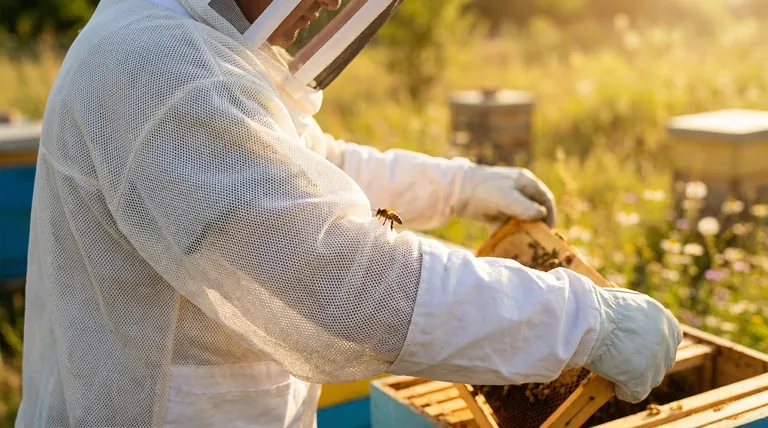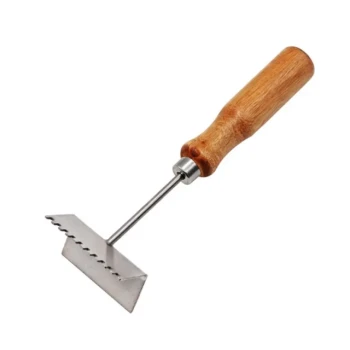At its core, a ventilated beekeeping suit balances sting protection and comfort through its unique material construction. Unlike traditional canvas, these suits use a multi-layer mesh fabric that is intentionally thick. This thickness creates a gap greater than the length of a honeybee's stinger, preventing it from reaching your skin, while the open weave of the mesh allows for constant airflow, keeping you cool.
The key is a simple principle: thickness provides the protection, while the material's open structure provides the ventilation. It's a design that separates the protective barrier from your skin, ensuring safety without trapping heat and moisture.

The Science of Sting Prevention
The effectiveness of a ventilated suit isn't magic; it's based on the physical limitations of a honeybee's stinger. The design cleverly exploits this to create a safe working environment.
The Critical Role of Thickness
A honeybee's stinger is typically 1.5 to 3 millimeters long. Ventilated suits are constructed with a sandwich of mesh layers that creates a total thickness significantly greater than this length.
Even if a bee attempts to sting, its stinger cannot bridge the gap from the outer surface of the suit to the beekeeper's skin. This physical space is the primary defense mechanism.
How the Mesh Structure Works
The material itself is not a solid sheet like cotton or canvas. It is a porous, three-dimensional fabric.
This mesh design is what allows air to pass through freely, carrying away body heat and perspiration. You get the protective depth without the suffocating heat of a dense, non-breathable fabric.
Maximizing Comfort Through Airflow
The most significant advantage of a ventilated suit is the dramatic improvement in comfort, especially during long inspections on hot, sunny days. This is a direct solution to the biggest complaint about traditional beekeeping gear.
A Major Leap from Traditional Suits
Traditional bee suits are made from thick cotton canvas. While effective at preventing stings, they are notoriously hot and trap humidity, leading to rapid overheating and exhaustion.
Ventilated suits solve this problem directly. The constant airflow feels like you're working in the shade, even when in direct sun, profoundly changing the beekeeping experience.
The Impact on Mobility and Focus
When you aren't overheating, you can work longer, with greater focus and calmer movements. This not only improves your enjoyment but also leads to better beekeeping, as a calm beekeeper is less likely to agitate the bees.
The lighter, more flexible nature of the mesh material also allows for better mobility compared to stiff canvas suits.
Understanding the Trade-offs
While highly effective, ventilated suits are not without their own set of considerations. Objectivity requires acknowledging their potential downsides compared to traditional options.
Durability and Snagging
The mesh material, while strong, can be more susceptible to snagging on sharp branches or equipment than thick, tightly-woven canvas. Care must be taken when working in rough environments.
Higher Initial Cost
The complex, multi-layer construction of ventilated suits typically makes them more expensive than their traditional cotton counterparts. This is a key factor for beekeepers on a tight budget.
Potential for Debris
The open weave of the mesh can sometimes allow very fine dust or debris to pass through, which is less of an issue with solid canvas suits.
Making the Right Choice for Your Climate
Your decision should be guided by your specific working conditions and priorities.
- If your primary focus is comfort in hot or humid climates: A ventilated suit is the definitive and superior choice, dramatically improving your endurance and enjoyment.
- If your primary focus is maximum durability for rugged work: A high-quality, thick canvas suit may offer a slight edge in resistance to tearing and abrasion.
- If your primary focus is the lowest possible cost: A traditional cotton suit remains the most budget-friendly option for getting started, but be prepared for the heat.
Ultimately, choosing the right suit empowers you to be a calmer, more effective, and more comfortable beekeeper.
Summary Table:
| Feature | Ventilated Suit | Traditional Canvas Suit |
|---|---|---|
| Sting Protection | Excellent (via material thickness) | Excellent |
| Breathability & Comfort | Superior (constant airflow) | Poor (traps heat) |
| Ideal For | Hot/Humid climates, long inspections | Rugged work, budget-conscious beekeepers |
| Key Consideration | Higher initial cost, potential for snagging | Can cause overheating and exhaustion |
Work Longer and Safer in Any Weather
Upgrade your apiary's efficiency and beekeeper comfort with professional-grade gear from HONESTBEE. Our ventilated suits are engineered for commercial beekeepers and distributors who demand superior sting protection without sacrificing performance during long, hot days.
We supply durable, reliable beekeeping supplies and equipment through wholesale-focused operations, ensuring your business has the tools for success.
Contact HONESTBEE today for wholesale pricing and to find the perfect protective gear for your operation.
Visual Guide

Related Products
- Vented Beekeeping Jacket with Hood and Veil for Beekeepers
- Cotton Beekeeping Suit and Round Hat with Veil Bee Keeper Protective Gear
- 3 Layer Mesh Vented Sting Proof Beekeeping Suit with Hat and Veil
- Yellow Plastic Bucket Pail Perch for Beekeeping
- Long Langstroth Style Horizontal Top Bar Hive for Wholesale
People Also Ask
- What are the advantages of reinforced stitching and durable zippers in beekeeping suits? Ensure Maximum Safety & Longevity
- Why is it important to close all zips and fasten buttons before washing a beekeeping suit? Protect Your Suit & Your Safety
- What are the benefits of a fully ventilated beekeeping suit? Stay Cool and Protected in Hot Climates
- Why is a jacket with a hat veil recommended for beekeepers? Essential Protection for Your Face and Neck
- What should be considered regarding the color of beekeeping clothing? Ensure Your Safety and Keep Bees Calm



















